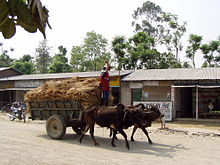Ox cart

The ox cart is a single-axle wagon pulled by two oxen , which has been archaeologically proven as early as the late Neolithic . When used on solid ground (later on roads), one animal was sometimes enough. From the late Middle Ages onwards, for economic reasons (traction plus secondary products), cows such as the Glan cattle were used as draft animals. Only the cart has a tilt function thanks to its integrated drawbar. Bulk material can be emptied very quickly by unhinging the draft animals.
Triangular car
The triangular wagon , a Neolithic form of the cart from the circumalpine region, is one of the oldest cargo transporters that were moved by oxen (probably as early as 3500 BC). As a rule, the cart has a rigid axle and a drawbar integrated into the load carrier , by means of which the draft cattle is connected via a yoke .
photos
The depiction on a rock painting in Val de Fontanalbe (in the Ligurian Alps) France, which shows two cattle in a yoke pulling a single-axle, two-wheeled cart ( triangular wagon ), can probably be dated to the Bronze Age .
Further development

Oxen pulled the wagons under the yoke . It was not until much later that horses were harnessed to carts with heavy loads using the collar . In Central Europe, the ox-cart lost its position compared to the horse-drawn cart , as oxen can develop less strength than properly harnessed horses.
With industrialization in Western Europe, tractors with trailers have largely replaced the ox cart. It is mostly only used for folklore purposes.
In large parts of Africa, the ox cart was and is practically unknown. However, the advance of the Boer Voortrekker into the interior of today's South Africa took place with multi-axle ox wagons ( ossewag ). In the event of danger, they formed a castle of wagons with the wagons . In Eastern Europe and large parts of Asia, the ox cart is still widely used in rural areas as a transport vehicle, especially in agriculture.
See also
literature
- Mamoun Fansa, Stefan Burmeister (ed.): Wheel and car. The origin of an innovation. Cars in the Middle East and Europe. Von Zabern, Mainz 2004, ISBN 3-8053-3322-6
- Joachim Köninger et al. (Ed.): Loop, sledge, wheel and carriage. On the question of early means of transport north of the Alps. In: Hemmenhofener Skripte 3, Freiburg 2002
- Jürgen E. Walkowitz: Logistics in the Neolithic and Chalcolithic. In: Varia neolithica IV, 2006, ISBN 3-937517-43-X
